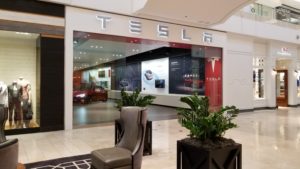 When we think about marketing, we rarely think about the distribution strategy of a company. Distribution, or placement, is the least sexy part of marketing but it is essential to building and maintaining the brand image. Distribution may even be a way to stand out. Think about Tesla for example. Part of the reason why Tesla can charge such high prices is because it creates an atmosphere of luxury. Tesla stores are always pristine. They are decorated with a sleek, high-end design to reflect the quality of the car.
When we think about marketing, we rarely think about the distribution strategy of a company. Distribution, or placement, is the least sexy part of marketing but it is essential to building and maintaining the brand image. Distribution may even be a way to stand out. Think about Tesla for example. Part of the reason why Tesla can charge such high prices is because it creates an atmosphere of luxury. Tesla stores are always pristine. They are decorated with a sleek, high-end design to reflect the quality of the car.
Tesla is clearly attempting to differentiate itself from its competitors. While competitors are generally located on large lots, Tesla stores are no larger than a typical clothing retail store. This gives visitors the feeling of exclusivity. Visitors see only one or two cars on the floor and assume that only a small number of cars are being made. This is in stark contrast to the feeling that customers likely get on a large lot of cars.
Moreover, Tesla is clearly trying to reach its customers at their everyday locations. To do so, Tesla locates its stores in wealthy neighborhoods around other luxury retail stores. As shoppers visit their favorite clothing stores, they might just happen to pass by the Tesla store and decide to go inside on a whim. There, knowledgeable employees greet the shoppers and have a conversation with them about the car. On the other hand, because auto dealerships require a lot of space, it would be too expensive for competitors to locate their stores in affluent areas. Moreover, those dealerships have cars for lower-income customers as well, so it would not be logical with their corporate strategy.
Yet another way that Tesla’s distribution strategy differs from the other car dealerships is the sales personnel Tesla employs. At most car dealership, the sales personnel is not very knowledgeable about all the specs of the car. Instead, they mostly follow a sheet of add-ons that they try to push to customers, once the customers have decided on a car. Contrastingly, Tesla sales personnel attempt to create a relationship with the potential customer. When a customer walks into the store, a sales personnel walks over to have a conversation about the brand and the car with the customer. They don’t push the car on the customer but instead let the specs speak for themselves.
It’s all of these aspects of their distribution strategy that help promote the luxury brand image of the company. Do you think that this would work to convince a customer to buy a Tesla car? Do you think it’s weird that a car dealership is located within a mall? Feel free to share your thoughts below!